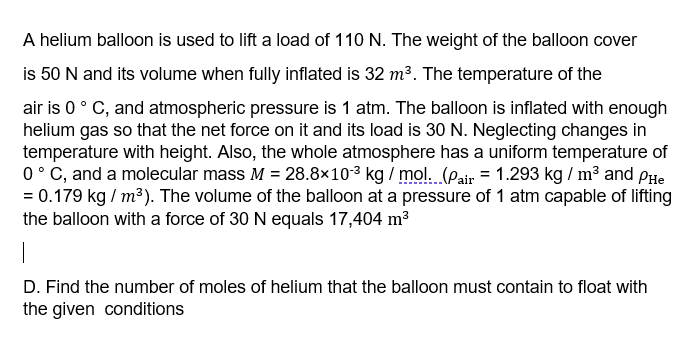A helium balloon is used to lift a load of 110 N. The weight of the balloon cover is 50 N and its volume when fully inflated is 32 m³. The temperature of the air is 0 ° C, and atmospheric pressure is 1 atm. The balloon is inflated with enough helium gas so that the net force on it and its load is 30 N. Neglecting changes in temperature with height. Also, the whole atmosphere has a uniform temperature of 0°C, and a molecular mass M = 28.8×10-3 kg / mol. (pair = 1.293 kg / m3 and PHe = 0.179 kg / m²). The volume of the balloon at a pressure of 1 atm capable of lifting the balloon with a force of 30 N equals 17,404 m³ D. Find the number of moles of helium that the balloon must contain to float with the given conditions
A helium balloon is used to lift a load of 110 N. The weight of the balloon cover is 50 N and its volume when fully inflated is 32 m³. The temperature of the air is 0 ° C, and atmospheric pressure is 1 atm. The balloon is inflated with enough helium gas so that the net force on it and its load is 30 N. Neglecting changes in temperature with height. Also, the whole atmosphere has a uniform temperature of 0°C, and a molecular mass M = 28.8×10-3 kg / mol. (pair = 1.293 kg / m3 and PHe = 0.179 kg / m²). The volume of the balloon at a pressure of 1 atm capable of lifting the balloon with a force of 30 N equals 17,404 m³ D. Find the number of moles of helium that the balloon must contain to float with the given conditions
Introductory Chemistry: An Active Learning Approach
6th Edition
ISBN:9781305079250
Author:Mark S. Cracolice, Ed Peters
Publisher:Mark S. Cracolice, Ed Peters
Chapter4: Introduction To Gases
Section: Chapter Questions
Problem 67E: The compression ratio in an automobile engine is the ratio of the gas pressure at the end of the...
Related questions
Question
d1) Answer the question shown in the image

Transcribed Image Text:A helium balloon is used to lift a load of 110 N. The weight of the balloon cover
is 50 N and its volume when fully inflated is 32 m³. The temperature of the
air is 0° C, and atmospheric pressure is 1 atm. The balloon is inflated with enough
helium gas so that the net force on it and its load is 30 N. Neglecting changes in
temperature with height. Also, the whole atmosphere has a uniform temperature of
0° C, and a molecular mass M = 28.8×103 kg / mol. (pair = 1.293 kg / m³ and PHe
= 0.179 kg / m³). The volume of the balloon at a pressure of 1 atm capable of lifting
the balloon with a force of 30 N equals 17,404 m³
D. Find the number of moles of helium that the balloon must contain to float with
the given conditions
Expert Solution
This question has been solved!
Explore an expertly crafted, step-by-step solution for a thorough understanding of key concepts.
Step by step
Solved in 3 steps

Knowledge Booster
Learn more about
Need a deep-dive on the concept behind this application? Look no further. Learn more about this topic, chemistry and related others by exploring similar questions and additional content below.Recommended textbooks for you

Introductory Chemistry: An Active Learning Approa…
Chemistry
ISBN:
9781305079250
Author:
Mark S. Cracolice, Ed Peters
Publisher:
Cengage Learning

Chemistry: The Molecular Science
Chemistry
ISBN:
9781285199047
Author:
John W. Moore, Conrad L. Stanitski
Publisher:
Cengage Learning


Introductory Chemistry: An Active Learning Approa…
Chemistry
ISBN:
9781305079250
Author:
Mark S. Cracolice, Ed Peters
Publisher:
Cengage Learning

Chemistry: The Molecular Science
Chemistry
ISBN:
9781285199047
Author:
John W. Moore, Conrad L. Stanitski
Publisher:
Cengage Learning


Chemistry
Chemistry
ISBN:
9781305957404
Author:
Steven S. Zumdahl, Susan A. Zumdahl, Donald J. DeCoste
Publisher:
Cengage Learning

General Chemistry - Standalone book (MindTap Cour…
Chemistry
ISBN:
9781305580343
Author:
Steven D. Gammon, Ebbing, Darrell Ebbing, Steven D., Darrell; Gammon, Darrell Ebbing; Steven D. Gammon, Darrell D.; Gammon, Ebbing; Steven D. Gammon; Darrell
Publisher:
Cengage Learning

Chemistry & Chemical Reactivity
Chemistry
ISBN:
9781337399074
Author:
John C. Kotz, Paul M. Treichel, John Townsend, David Treichel
Publisher:
Cengage Learning